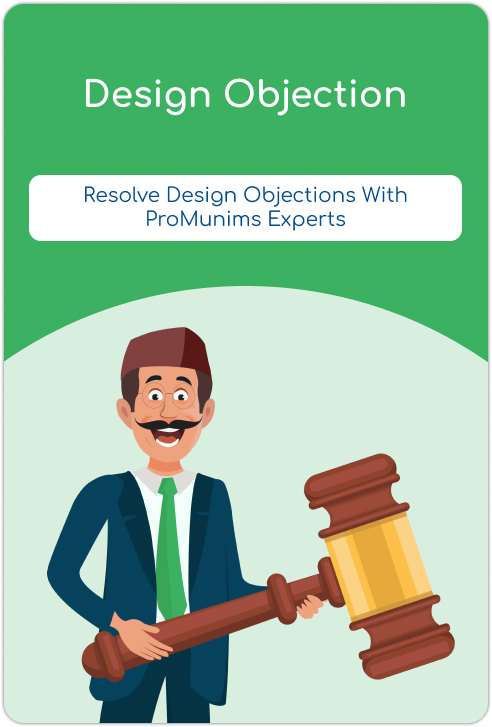
Design Objection
56 customers
What will you get?
Strategic Approach
Expert Guidance
Efficiency and Timeliness
Maximized Success Rate
Long-Term Value
What do we Require?
INR 7252 Taxes As Applicable






Introduction
Design objections occur when the intellectual property office or authority examining a design registration application raises concerns or issues regarding the eligibility or registrability of the design. These objections may arise for various reasons, and addressing them is essential for successfully obtaining design registration. Here are some common reasons for design objections and how they can be addressed:
Lack of Novelty or Originality:
One of the primary requirements for design registration is that the design must be new and original. If the examiner finds that the design lacks novelty or is not sufficiently distinct from existing designs, they may raise an objection. To address this, the applicant can provide arguments or evidence demonstrating the unique features and distinguishing characteristics of the design compared to prior art.
Functional Features:
Design registration is intended to protect the aesthetic or ornamental aspects of a product, rather than its functional features. If the examiner determines that the design is primarily functional in nature, they may object to its registrability. To overcome this objection, the applicant can emphasize the non-functional aspects of the design and clarify how its ornamental features contribute to its overall appearance.
Non-Compliance with Formal Requirements:
Design registration applications must meet certain formal requirements, such as providing accurate representations or drawings of the design and submitting the required documents and information. Failure to comply with these requirements may lead to objections. To address this, the applicant can correct any deficiencies or errors in the application and ensure that all necessary documents and information are properly submitted.
Conflicts with Prior Rights:
If the examiner identifies conflicts with prior design registrations or other intellectual property rights, they may raise objections to the registrability of the design. To resolve this issue, the applicant can conduct a thorough search to identify existing rights and assess the potential for conflicts. If conflicts are found, the applicant may need to modify the design to avoid infringement or negotiate with the rights holders to reach a resolution.
Deceptive Similarity:
If the design is deemed deceptively similar to existing designs or trademarks, the examiner may object to its registrability. To address this, the applicant can provide arguments or evidence demonstrating the differences between the designs and explaining how the proposed design is distinct and recognizable in its own right.
Procedural or Administrative Issues:
Objections may also arise due to procedural or administrative issues, such as incomplete or incorrect application forms, missing documents, or failure to pay required fees. To resolve these issues, the applicant should carefully review the examiner's objections and take appropriate corrective actions, such as submitting missing documents or rectifying errors in the application.
Reply to Design Objection:
- Acknowledgment of Objection:Begin by acknowledging the objection raised by the examiner and expressing appreciation for the thorough review of the application.
- Clarification of Design Features:Provide a detailed description of the design's features, emphasizing its unique and distinctive elements. Highlight any novel aspects of the design that differentiate it from existing designs in the marketplace.
- Comparison with Prior Art:Conduct a comparative analysis of the design with relevant prior art, including existing designs and any references cited by the examiner. Demonstrate how the design differs from prior art in terms of shape, configuration, pattern, or ornamentation.
- Explanation of Non-Functional Features:Clarify the non-functional nature of the design's ornamental features and how they contribute to its overall appearance. Emphasize that the design primarily serves an aesthetic or decorative purpose rather than a functional one.
- Evidence of Novelty and Originality:Provide supporting evidence, such as design sketches, renderings, prototypes, or market research data, to substantiate the novelty and originality of the design. Show how the design represents a significant departure from existing designs and fulfils the criteria for registrability.
- Resolution of Conflicts with Prior Rights:If conflicts with prior design registrations or other intellectual property rights are identified, propose solutions for resolving these conflicts, such as modifying the design to avoid infringement or negotiating with rights holders for consent.
- Correction of Procedural Issues:Address any procedural or administrative issues raised by the examiner, such as incomplete application forms, missing documents, or payment errors. Provide the necessary corrections or additional information to rectify these issues.
- Conclusion and Request for Registration:Conclude the reply by summarizing the key points made in response to the objection and reaffirming the eligibility of the design for registration. Request that the examiner reconsider the application in light of the arguments and evidence presented.
- Enclosures:Include any relevant supporting documents, such as design drawings, descriptions, references, or legal arguments, as enclosures to the reply.
- Professional Review:Before submitting the reply, have it reviewed by intellectual property professionals, such as attorneys or agents specializing in design registration, to ensure clarity, accuracy, and compliance with legal requirements.
Promunim Design objection service provides:
Promunim offers comprehensive design objection services to help clients navigate the design registration process and secure successful registrations. With in-depth knowledge of intellectual property laws and regulations, they provide tailored solutions to address objections raised by patent offices or authorities. Promunim analyses objection grounds, prepares detailed responses, and communicates with patent offices to ensure favourable outcomes. They prioritize client satisfaction and deliver results-driven solutions that align with business objectives and intellectual property strategies. Entrusting Promunim with your design objection needs ensures your intellectual property rights are in capable hands, ensuring peace of mind.

